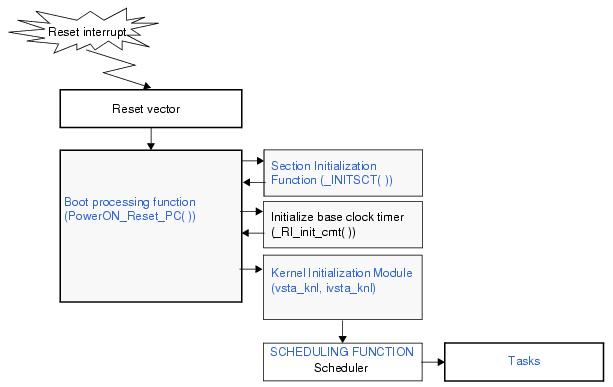#include <machine.h>
#include <_h_c_lib.h>
//#include <stddef.h> // Remove the comment when you use errno
//#include <stdlib.h> // Remove the comment when you use rand()
#include "typedefine.h" // Define Types
#include "kernel.h" // Provided by RI600V4
#include "kernel_id.h" // Generated by cfg600
#if (((_RI_CLOCK_TIMER) >=0) && ((_RI_CLOCK_TIMER) <= 3))
#include "ri_cmt.h" // Generated by cfg600
// Do comment-out when clock.timer is either NOTIMER or OTHER.
#endif
#ifdef __cplusplus
extern "C" {
#endif
void PowerON_Reset_PC(void);
void main(void);
#ifdef __cplusplus
}
#endif
//#ifdef __cplusplus // Use SIM I/O
//extern "C" {
//#endif
//extern void _INIT_IOLIB(void);
//extern void _CLOSEALL(void);
//#ifdef __cplusplus
//}
//#endif
#define FPSW_init 0x00000000 // FPSW bit base pattern
//extern void srand(_UINT); // Remove the comment when you use rand()
//extern _SBYTE *_s1ptr; // Remove the comment when you use strtok()
//#ifdef __cplusplus // Use Hardware Setup
//extern "C" {
//#endif
//extern void HardwareSetup(void);
//#ifdef __cplusplus
//}
//#endif
//#ifdef __cplusplus // Remove the comment when you use global class object
//extern "C" { // Sections C$INIT and C$END will be generated
//#endif
//extern void _CALL_INIT(void);
//extern void _CALL_END(void);
//#ifdef __cplusplus
//}
//#endif
#pragma section ResetPRG // output PowerON_Reset to PResetPRG section
/////////////////////////////////////////////////////////////////////////////
// Boot processing
/////////////////////////////////////////////////////////////////////////////
#pragma entry PowerON_Reset_PC
void PowerON_Reset_PC(void)
{
#ifdef __ROZ // Initialize FPSW
#define _ROUND 0x00000001 // Let FPSW RMbits=01 (round to zero)
#else
#define _ROUND 0x00000000 // Let FPSW RMbits=00 (round to nearest)
#endif
#ifdef __DOFF
#define _DENOM 0x00000100 // Let FPSW DNbit=1 (denormal as zero)
#else
#define _DENOM 0x00000000 // Let FPSW DNbit=0 (denormal as is)
#endif
// set_extb(__sectop("FIX_INTERRUPT_VECTOR"));// Initialize EXTB register
// (only for RXv2 arch.)
set_fpsw(FPSW_init | _ROUND | _DENOM);
_INITSCT();
// _INIT_IOLIB(); // Use SIM I/O
// errno=0; // Remove the comment when you use errno
// srand((_UINT)1); // Remove the comment when you use rand()
// _s1ptr=NULL; // Remove the comment when you use strtok()
// HardwareSetup(); // Use Hardware Setup
nop();
// set_fintv(<handler address>); // Initialize FINTV register
#if (((_RI_CLOCK_TIMER) >=0) && ((_RI_CLOCK_TIMER) <= 3))
_RI_init_cmt(); // Initialize CMT for RI600V4
// Do comment-out when clock.timer is either NOTIMER or OTHER.
#endif
// _CALL_INIT(); // Remove the comment when you use global class object
vsta_knl(); // Start RI600V4
// Never return from vsta_knl
// _CLOSEALL(); // Use SIM I/O
// _CALL_END(); // Remove the comment when you use global class object
brk();
}
/////////////////////////////////////////////////////////////////////////////
// System down routine for RI600V4
/////////////////////////////////////////////////////////////////////////////
#pragma section P PRI_KERNEL
#pragma section B BRI_RAM
struct SYSDWN_INF{
W type;
VW inf1;
VW inf2;
VW inf3;
};
volatile struct SYSDWN_INF _RI_sysdwn_inf;
void _RI_sys_dwn__( W type, VW inf1, VW inf2, VW inf3 )
{
// Now PSW.I=0 (all interrupts are masked.)
_RI_sysdwn_inf.type = type;
_RI_sysdwn_inf.inf1 = inf1;
_RI_sysdwn_inf.inf2 = inf2;
_RI_sysdwn_inf.inf3 = inf3;
while(1)
;
}
/////////////////////////////////////////////////////////////////////////////
// RI600V4 system data
/////////////////////////////////////////////////////////////////////////////
#include "kernel_ram.h" // generated by cfg600
#include "kernel_rom.h" // generated by cfg600
|
